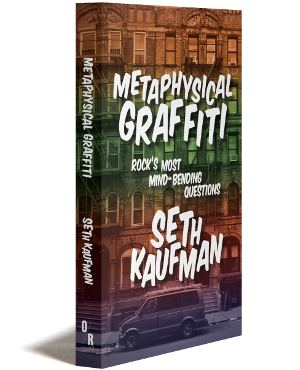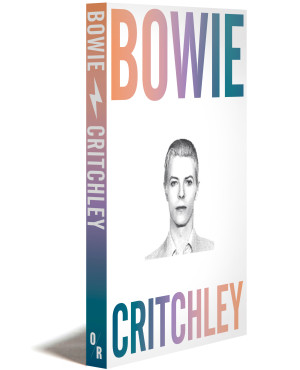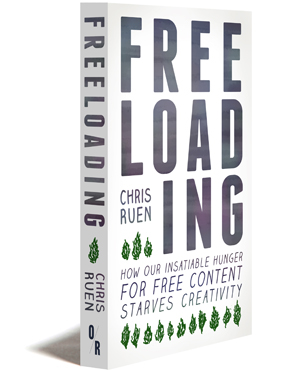
Metaphysical Graffiti
ROCK’S MOST MIND-BENDING QUESTIONS
“Metaphysical Graffiti will make you think twice (and laugh thrice).” —Will Hermes, author, Love Goes to Buildings on Fire
“A genial foray into the meaning of rock ’n’ roll.” —Kirkus
“If you liked Better Living Through Criticism—or, to be honest, if you wished it was funnier and shorter, with more about Billy Joel—you might dig this book.” —A.O. Scott
TweetBuy This Book
|
Paperback: $17/£12
|
E-book: $10/£7
|
Print + E-book: >$22/£16
|
About the Book
Metaphysical Graffiti is a book for music fans, humor fans, and, if a meaningful ontological category, fans of philosophy too. It is a provocative, inflammatory, hilarious, but ultimately serious book about the essential questions of rock—Beatles or Stones? What Kind of Air Guitar Do You Play? Does Rush Suck? and, of course, The Meaning of Billy Joel. In a rich mix of original pieces, Kaufman not only examines the essential issues facing all rock fans, but delves into the deeper, metaphysical roots of these questions.
The book’s title is a riff on the classic Led Zeppelin album, Physical Graffiti, while the book itself is an innovative, critical work that in many ways mirrors the best rock ‘n’ roll. Funny, audacious, irreverent, and relentlessly creative, it stretches the parameters of traditional criticism by incorporating short fiction, “Moronic Dialogues,” and even a short mini-play, “Godot, The Musical,” in order to explore philosophical concepts of Reality, Authenticity, Hype, and, ultimately, the purpose of music criticism itself.
196 pages • Paperback ISBN 978-1-682191-67-5 • E-book 978-1-682191-68-2
About the Author
 |
Recovering musician Seth Kaufman grew up overseas, in Kenya and India, the son of a foreign correspondent. He ran a popular online music store where he sold so many copies of Kenny G records he should be tried at The Hague. He has written a number of books, including The King of Pain (“One of 2012’s most enjoyable novels” —The New York Times), contributed humor pieces to the New Yorker website and freelanced for many other publications. |
Read an Excerpt
AN ACOUSTIC INTRO
The Anne and Bernard Spitzer Hall of Human Origins in the American Museum of Natural History in New York City gives visitors an overview of millions of years of human history. It’s a slick and informative exhibit about our ancestors and evolution. Among the highlights on display, you can see Lucy, the finest 2-to-4 million year-old hominid specimen in existence.
The exhibit has a small display about music, which of course is very much part of the human experience, and unique to the species. Birds aren’t “singing” because they are happy. They make sounds that may sound like music at times, but those sounds are not music; no, those sounds are the result of an ingrained, inherited reflex.
A section in the music display is titled HOW AND WHY DID MUSIC ORIGINATE? It speculates on a number of possible social functions of music, noting it could have been “used for courtship, territorial claims, and uniting social groups.” And it ends with this: “Whatever its original uses, music is now present in every human culture, implying that a biological capacity for music evolved early in our species’ history.”
I love this sign because, in a world-class museum that is dedicated to studying, cataloging, displaying and explaining so much of the natural world, what this sign really says is: Nobody knows when or why music first started, but we think it must be goddamn important. So music, it turns out, is a bigger black hole than a black hole itself. I’m not kidding: Go to New York’s Rose Center for Earth and Space, right next door to the Museum of Natural History, and you will see that we know far more about the origins and the structure of the universe than we do about the origins of music. There’s even a super-cool four-minute movie exhibit in a concave theater about the Big Bang. It’s a bit more elaborate than three or four speculative paragraphs about the origins of music at Spitzer Hall.
This makes sense. The first music left no swirling cosmos to measure, no rate of expansion, no bones to examine, no sheet music, no instruments. There was no iPhone to capture the first handclap, the first drumbeat, or the first harmony, never mind the first song—all those initial sounds have vanished. Perhaps one day scientists will be able to somehow capture the ancient sound waves of Lucy singing in Kenya to her hominid clan. But until those long-vanished waves are retrieved—which seems like a plot from an unwritten Michael Crichton novel —we are clueless.
The other reason I love the sign at Spitzer Hall is that I’ve been asking myself why music exists and what its purpose is ever since I heard “Mr. Roboto,” a ridiculous song by Styx, in the mid 1980s. And the museum answer—or non-answer—may be frustrating at first, but I also find it empowering. If there’s no answer to the Biggest Fucking Question—“Why music?”—and all the smartest guys in the museum have to work with is speculation, then the other Big Fucking Questions that consume us about music and music culture—Beatles or Stones? Does Rush Suck?—seem equally open to debate and speculation, and perhaps, in relative terms, are potentially answerable. Metaphysical Graffiti tackles some of the most important and contentious Big Fucking Questions about music, specifically rock and pop music, and about those who listen to it. The BFQs may seem inane to someone who doesn’t see the importance or the difficulty of picking the Beatles over the Stones or the Stones over the Beatles. Questioning the authenticity of Billy Joel may seem absurd to someone who doesn’t care about Billy Joel in the first place, or (shudder!) loves him unquestioningly, or doesn’t care about why they shouldn’t care about Billy Joel. But these are not just stupid/funny rockhead questions to inspire comic debate — although they are that, too. They are also questions that, if we take them seriously, force us to look deeper into the relationship between music and our lives, and how we are shaped and how music is shaped.
In the end, I hope this book will provide some insight into unanswerable questions. Not to the original “Why music?” question—which no doubt is rooted in strengthening communal bonding among huntergatherers, finding the perfect mate, or some other very sensible evolutionary reason. But answers to the meaning of music for each of us, and answers to the questions that music inspires. Ultimately, music is fascinating not just because of the complexity of notes or its sophisticated meter or its moving lyrics, but because of its many mystical powers to move us and consume us, to make us want to dance, to listen to it over and over again, or rush to turn it off, or analyze it, feel it, react to it, judge it, bathe in it or reject it, and then re-engage with it all over again.
And then, in a perfect world, find somebody you can argue with about it.
In the Media
- “ Tackling contentious questions about rock and pop music, forcing us to look deeper into our relationship with music; how we shape it, and how it shapes us.” —Showcase on SETH KAUFMAN’s METAPHYSICAL GRAFFITI (4/24/2019)
- “A genial foray into the meaning of rock ’n’ roll.”- METAPHYSICAL GRAFFITI reviewed in Kirkus Reviews (10/10/2018)
- “This is a book that the reader will love and hate and thoroughly enjoy.” – METAPHYSICAL GRAFFITI reviewed at Evil Cyclist (8/6/2018)
- “Erudite, caustic and hilarious… creative non-fiction writing at its best.” METAPHYSICAL GRAFFITI reviewed in The Morning Star (7/18/2018)





